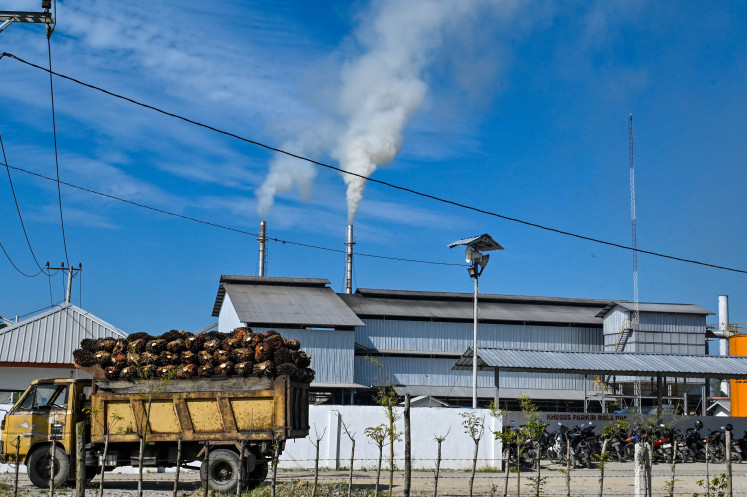Popular Reads
Top Results
Can't find what you're looking for?
View all search resultsPopular Reads
Top Results
Can't find what you're looking for?
View all search resultsBottlesmoker showcases traditional sounds in new album
Bottlesmoker: Anggung ‘Angkuy’ Suherman (left) and Ryan ‘Nobie’ Adzani
Change text size
Gift Premium Articles
to Anyone
Bottlesmoker: Anggung ‘Angkuy’ Suherman (left) and Ryan ‘Nobie’ Adzani.
Electronic duo Bottlesmoker, Anggung “Angkuy” Suherman and Ryan “Nobie” Adzani, dive deep into Indonesian culture in their latest release.
Working with traditional sound collector Aural Archipelago, the Bandung-based band Bottlesmoker uses a compelling template of sampled Indonesian instruments and chants to build what is undoubtedly its most evocative work to date.
The songs on Parakosmos burst with a nationalistic romancing of tribal ambience, which finds a surprisingly comfortable partner in Bottlesmoker’s minimalist electro-pop blips.
As always, Bottlesmoker released the record in a variety of formats, including as a free download complete with high-resolution album art. Those familiar with the group will know that all of their previous albums were also released online for free, which was how they initially built an audience.
Taking its title from an amalgamation of the words paradoks (paradox) and kosmos (cosmos), the record’s foundation might be a gimmick, but it’s one that truly enhances the duo’s usual fun but lighthearted melodic electronic tunes.
At its best, Parakosmos feels like the group and the sampled musicians worked in tandem, and that everything was recorded live in a room together.
While the album is indeed a piece of studio work, it manages to sound like a live performance. Sentimentally, it would even be right to say that it feels like a particularly spiritual electronic record.
There are moments when things get into usual Bottlesmoker territory (meaning fun but feathery-club pop that could use a little roughness around its edges), but aside from their clearly honed sense of pacing and dynamics, the songs are vigorous in their melodic punch.
“Early in the writing process, we made sure that we were not just sticking to these traditional sounds; we wanted them to not merely stick, but truly blend with the songs. We did not want to make a ‘traditional’ album,” Angkuy said.
“You can really feel the impact of the hard, tribal and powerful musicality because of these new sounds. In the past, we tend to be more chill and cheerful.
“Aural Archipelago really pushed us to learn more about the values of the [traditional] rituals we were utilizing in the songs, so that we understood what we were making music with in terms of its cultural value.
“What’s really interesting is the way Aural Archipelago has made us work with these new patterns, these new motives that come out of traditional music.”
Working the table: Bottlesmoker returns with a new album that incorporates the sounds of traditional Indonesian musicians.
Aural Archipelago is the project of Palmer Keen, an American ethnomusicologist who has traveled around Indonesia collecting field recordings from familiar islands like Sumatra, Java and Borneo to less traversed areas such as Rote in East Nusat Tenggara (NTT) and Selayar in South Sulawesi. Keen often records traditional musicians in their environment, playing instruments that may not even be familiar to city dwelling Indonesians.
Bottlesmoker’s task was to fit both their melodic sense and production touches with these foreign sounds.
In some instances, the band would have to use the basis of a sampled kendang (percussive instrument) to build a beat around. In other instances, Angkuy and Nobie had to make sure all their synthesizer sounds lined up with the tarawangsa (violin-like instrument) from west Java.
The strongest and easiest element to discern are the singers and choir, which provide the record with some of its grandest moments. These voices were recorded across the country, from Tasikmalaya’s Beluk culture in West Java, to Panggaiyang flourishes of NTT’s East Sumba regency.
“During the production process, we came agreed that we needed to limit the working methods and presentation of this being a part of Indonesian culture,” Angkuy said.
“It’s far from a complete package that summarizes Indonesian traditions, but it’s a start for us to engage these things.”
The band made sure to avoid sounding like it was exploiting these sounds as a gimmick.
“These samples are part of a cultural archive and they have enormous value. So, we were very careful in making sure that we were not disrespecting these rituals that have been passed down through generations. We wanted to approach [the album] as us being inspired by local culture and passing on that sense of inspiration to our friends and fans,” said Nobie.
Angkuy said the album also inspired them to embrace their homeland.
“In the past, we would create visuals and take band photos in places that looked foreign or use effects to make [the location] seem foreign. But during the recording of this album, we started to shed those ideas. Now, when we take a band photo in which you can see goats or banana trees in the background, we just go, ‘that’s cool.’ We live in Indonesia and this is what [the country] is really like.”
________________________________
Visit yesnowave.com to download Parakosmos for free.











